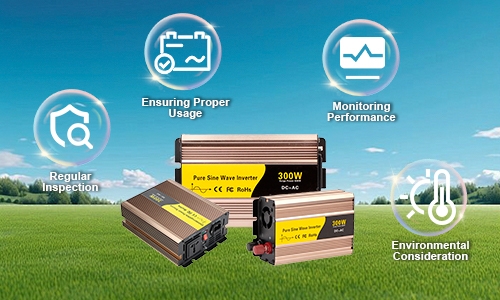A pure sine wave inverter is a crucial component in many electrical systems, particularly for sensitive electronics and appliances that require clean and stable power. Unlike modified sine wave power inverters, pure sine wave inverters provide a smooth, consistent wave similar to the power supplied by the utility grid, ensuring electronic devices' safe and efficient operation. Whether used in residential solar power systems, RVs, or backup power solutions, maintaining these inverters ensures their longevity and efficiency. Maintaining a pure sine wave inverter involves several key practices, from regular inspections to proper usage and environmental considerations. This article outlines essential tips and steps for maintaining a pure sine inverter to ensure its longevity and reliability.
Key components of a pure sine wave inverter:
- DC Input: The direct current (DC) input is typically sourced from batteries or solar panels.
- Inverter Circuit: Converts DC to alternating current (AC).
- Output Stage: Delivers the converted AC power to connected devices.
- Cooling System: Ensures the inverter remains within safe operating temperatures.
- Control System: Manages the inverter's operations, including voltage regulation and protection mechanisms.
What are the importance of maintenance?
Pure sine wave inverters are designed to convert direct current (DC) from sources like batteries or solar panels into alternating current (AC) that can be used by household appliances and other electronics. Maintaining a pure sine wave inverter is crucial for several reasons. Firstly, it ensures the efficient and reliable operation of sensitive electronic devices, such as medical equipment and computers, which require a stable and clean power supply to function correctly. Secondly, a well-maintained inverter can extend the lifespan of both the inverter itself and the connected devices by preventing damage from power surges and voltage fluctuations. Thirdly, regular maintenance helps to improve energy efficiency, reducing overall electricity costs. Additionally, it enhances safety by preventing potential hazards such as overheating and electrical fires. Lastly, consistent upkeep ensures compliance with warranty requirements and helps to avoid costly repairs or replacements. And there are some tips in the following.

What can we do?
1. Regular Inspection and Cleaning
- Visual Inspections. Performing regular visual inspections is one of the simplest yet most effective ways to maintain your pure sine wave power inverter. Check for any obvious signs of wear and tear, such as frayed wires, loose connections, or burnt components. Ensure that all connections are tight and secure to prevent any electrical faults.
- Cleaning. Dust and debris can accumulate inside the inverter, potentially causing overheating or short circuits. Regularly clean the inverter using a soft brush or compressed air to remove dust from the vents and internal components. Avoid using water or any liquid cleaners, as moisture can damage electronic components.
2. Monitoring Performance
- Check Output Voltage. Regularly monitor the output voltage of the inverter to ensure it is within the specified range. Deviations from the expected output can indicate underlying issues that need addressing. Most sine wave inverters come with built-in displays or can be connected to monitoring systems that provide real-time data on performance metrics.
- Temperature Monitoring. Overheating is a common cause of inverter failure. Ensure that the inverter operates within the recommended temperature range by monitoring its temperature regularly. Some inverters are equipped with temperature sensors and cooling fans; ensure these are functioning correctly. If the inverter frequently overheats, consider improving ventilation around the device or relocating it to a cooler environment.
3. Ensuring Proper Usage
- Load Management. Avoid overloading the pure sine inverter, as this can lead to overheating and potential damage. Ensure that the total power consumption of connected devices does not exceed the inverter's capacity. Spread the load evenly and disconnect unnecessary devices to reduce strain on the inverter.
- Battery Maintenance. For systems relying on batteries, maintaining the battery bank is equally important. Regularly check the batteries for signs of wear, corrosion, and proper electrolyte levels. Ensure that the batteries are charged and discharged according to the manufacturer's recommendations to maximize their lifespan and performance.
- The cooling system is critical for preventing overheating. Check that the cooling fans are working correctly and clean them regularly to prevent dust buildup. If the inverter uses a liquid cooling system, check the coolant levels and refill or replace as necessary.
4. Environmental Considerations
- Installation Location. Install the pure sine wave inverter in a location that is cool, dry, and well-ventilated. Avoid areas with high humidity or direct sunlight, as these conditions can accelerate wear and lead to overheating. A clean, dust-free environment will also minimize the need for frequent cleaning.
- Protection from Power Surges. Power surges can damage the inverter and connected devices. Use surge protectors to safeguard against voltage spikes, especially in areas prone to lightning strikes or unstable power supply. Some inverters come with built-in surge protection; if yours does not, consider adding external protection.
Maintaining a pure sine power inverter involves a combination of regular inspections, proper usage, and environmental considerations. By adhering to these maintenance practices, users can ensure the longevity, efficiency, and reliability of their inverters, thereby protecting their investments and the connected devices. Remember, preventive maintenance is always better than reactive repairs, so take proactive steps to keep your pure sine wave inverter in optimal condition. If you want to know more about the maintenance precautions of sine wave inverter, inverter.com will give you a help.
